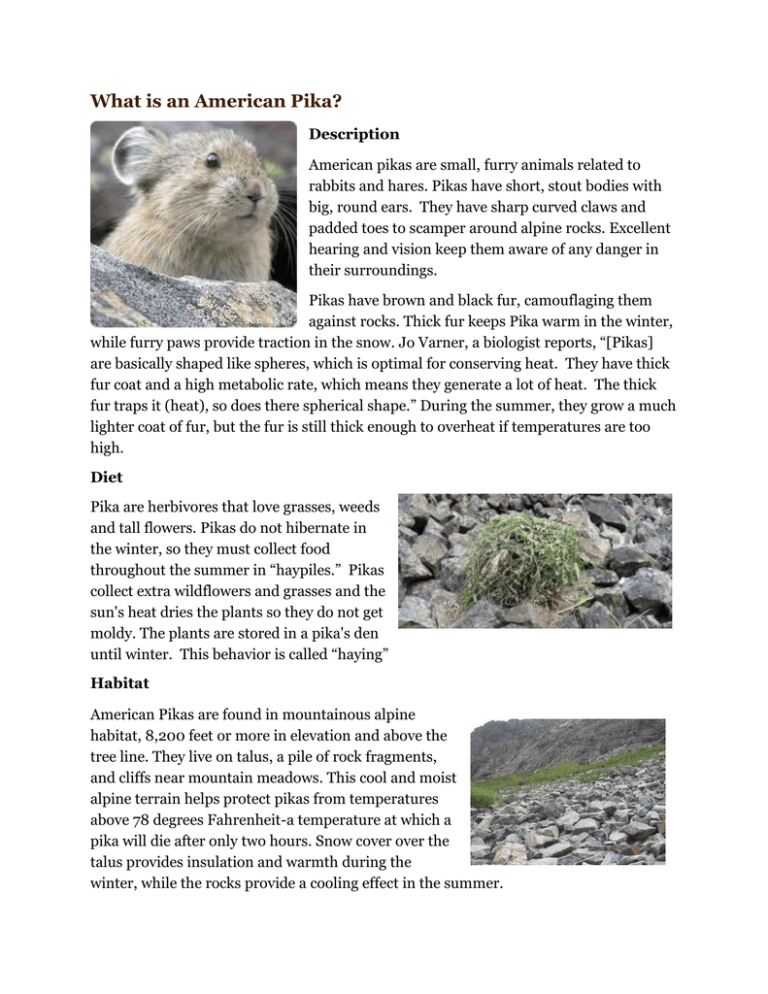Pika Fact Sheet
advertisement

What is an American Pika? Description American pikas are small, furry animals related to rabbits and hares. Pikas have short, stout bodies with big, round ears. They have sharp curved claws and padded toes to scamper around alpine rocks. Excellent hearing and vision keep them aware of any danger in their surroundings. Pikas have brown and black fur, camouflaging them against rocks. Thick fur keeps Pika warm in the winter, while furry paws provide traction in the snow. Jo Varner, a biologist reports, “[Pikas] are basically shaped like spheres, which is optimal for conserving heat. They have thick fur coat and a high metabolic rate, which means they generate a lot of heat. The thick fur traps it (heat), so does there spherical shape.” During the summer, they grow a much lighter coat of fur, but the fur is still thick enough to overheat if temperatures are too high. Diet Pika are herbivores that love grasses, weeds and tall flowers. Pikas do not hibernate in the winter, so they must collect food throughout the summer in “haypiles.” Pikas collect extra wildflowers and grasses and the sun's heat dries the plants so they do not get moldy. The plants are stored in a pika's den until winter. This behavior is called “haying” Habitat American Pikas are found in mountainous alpine habitat, 8,200 feet or more in elevation and above the tree line. They live on talus, a pile of rock fragments, and cliffs near mountain meadows. This cool and moist alpine terrain helps protect pikas from temperatures above 78 degrees Fahrenheit-a temperature at which a pika will die after only two hours. Snow cover over the talus provides insulation and warmth during the winter, while the rocks provide a cooling effect in the summer. How Pikas Communicate American pikas are often heard before they are seen. They make calls and sing to define and protect their territory, alert others to the presence of dangers and attract mates. The call sounds like the bleat of lamb, but is more highpitched and squeaky. Adaptations American pikas have adapted to living in very inhospitable environments. They live where most other mammals do not venture to go-the treeless slopes of mountains. It is very cold, rocky and treacherous for the tiny pika. Pikas help protect themselves by living in colonies. They live near other pikas and will alert the group to predators by sending out a warning call. Weasels, hawks and coyotes can prey on pikas. Although pikas live in colonies, they are very territorial over their den and surrounding area. They will give off territorial calls to define the boundaries between each pika neighbor. They make their dens among rocks. Pikas are active in the daytime and they do not hibernate in winter. They are active throughout the year, but they tend to spend most of their time inside the den in the winter. Pikas eat stored grasses to survive and venture out to forage when the weather permits. Unlike other mountain species that can move to higher altitudes in warming climates, pikas live so high on the mountain that there is nowhere for them to go. Without our protection and help, American pikas could be the first species with the distinction of going extinct due to global warming. Map of Pika locations in Utah. Circles = Since 1983 Squares = Before 1983







